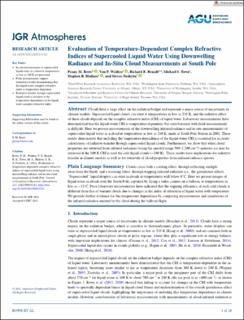| dc.contributor.author | Rowe, Penny M. | |
| dc.contributor.author | Walden, Von P. | |
| dc.contributor.author | Brandt, Richard E. | |
| dc.contributor.author | Town, Michael Stephen | |
| dc.contributor.author | Hudson, Stephen | |
| dc.contributor.author | Neshyba, Steven | |
| dc.date.accessioned | 2022-06-15T09:45:59Z | |
| dc.date.available | 2022-06-15T09:45:59Z | |
| dc.date.created | 2022-05-05T12:18:21Z | |
| dc.date.issued | 2022 | |
| dc.identifier.issn | 2169-897X | |
| dc.identifier.uri | https://hdl.handle.net/11250/2998841 | |
| dc.description.abstract | Clouds have a large effect on the radiation budget and represent a major source of uncertainty in climate models. Supercooled liquid clouds can exist at temperatures as low as 235 K, and the radiative effect of these clouds depends on the complex refractive index (CRI) of liquid water. Laboratory measurements have demonstrated that the liquid-water CRI is temperature-dependent, but corroboration with field measurements is difficult. Here we present measurements of the downwelling infrared radiance and in-situ measurements of supercooled liquid water in a cloud at temperatures as low as 240 K, made at South Pole Station in 2001. These results demonstrate that including the temperature dependence of the liquid-water CRI is essential for accurate calculations of radiative transfer through supercooled liquid clouds. Furthermore, we show that when cloud properties are retrieved from infrared radiances (using the spectral range 500–1,200 cm−1) spurious ice may be retrieved if the 300 K CRI is used for cold liquid clouds (∼240 K). These results have implications for radiative transfer in climate models as well as for retrievals of cloud properties from infrared radiance spectra. | en_US |
| dc.language.iso | eng | en_US |
| dc.publisher | American Geophysical Union | en_US |
| dc.title | Evaluation of Temperature-Dependent Complex Refractive Indices of Supercooled Liquid Water Using Downwelling Radiance and In-Situ Cloud Measurements at South Pole | en_US |
| dc.type | Journal article | en_US |
| dc.type | Peer reviewed | en_US |
| dc.description.version | publishedVersion | en_US |
| dc.rights.holder | Copyright 2021 American Geophysical Union. | en_US |
| dc.source.articlenumber | e2021JD035182 | en_US |
| cristin.ispublished | true | |
| cristin.fulltext | original | |
| cristin.qualitycode | 2 | |
| dc.identifier.doi | 10.1029/2021JD035182 | |
| dc.identifier.cristin | 2021720 | |
| dc.source.journal | Journal of Geophysical Research (JGR): Atmospheres | en_US |
| dc.identifier.citation | Journal of Geophysical Research (JGR): Atmospheres. 2022, 127 (1), e2021JD035182. | en_US |
| dc.source.volume | 127 | en_US |
| dc.source.issue | 1 | en_US |
